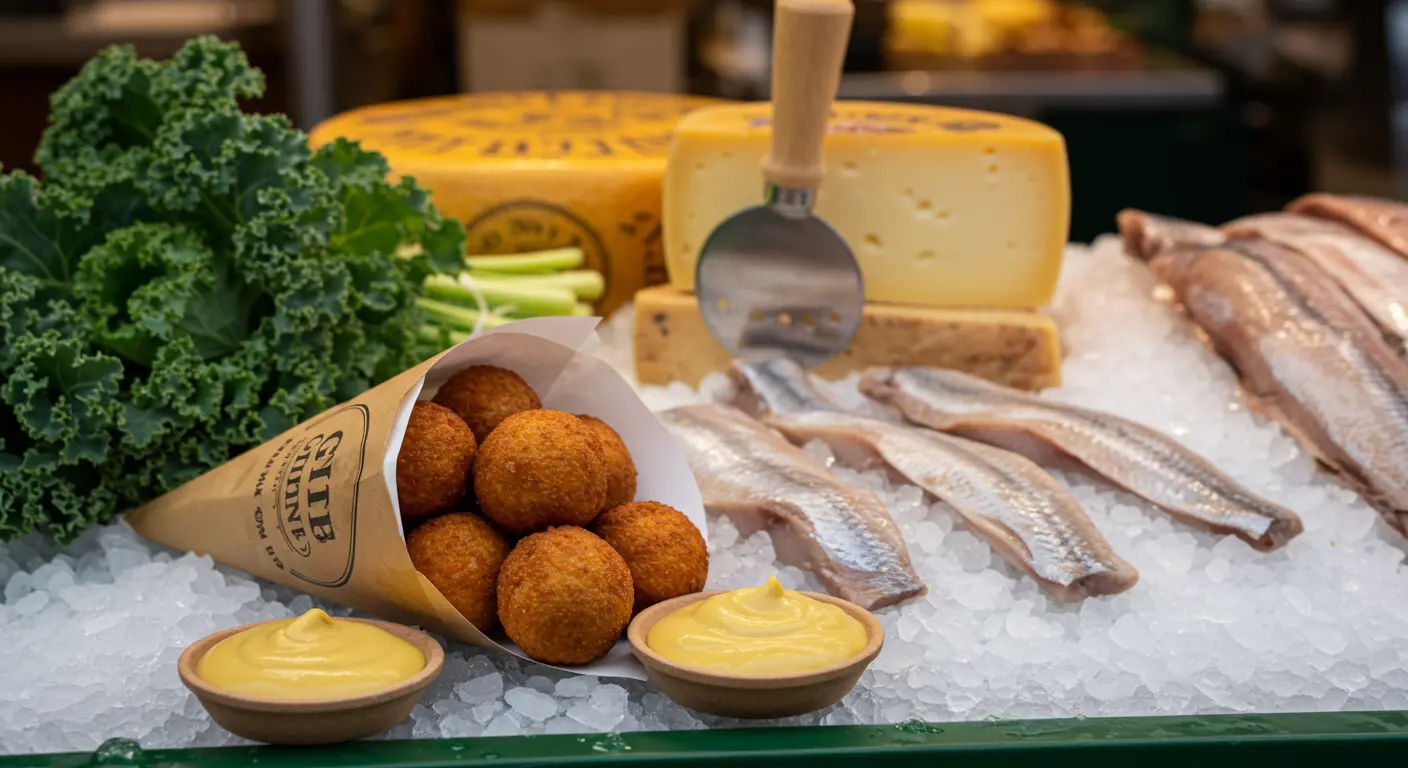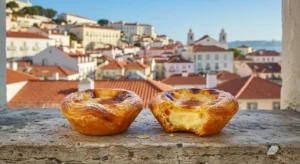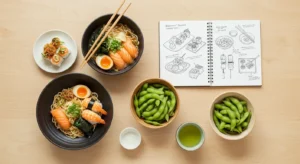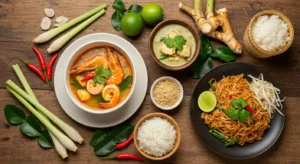Table of Contents
A Beginner’s Guide to Dutch Food: More Than Just Cheese and Windmills
Picture this: you’re cycling along a canal in Amsterdam, the crisp air nipping at your cheeks. You’ve just spent hours marveling at Van Gogh and Rembrandt, and now a deep, primal hunger sets in. But what do you eat? Sure, you know about Gouda cheese, but there must be more to Dutch food than that, right?
You’ve come to the right place. Dutch cuisine is often overlooked, hiding in the shadows of its French and Italian neighbors. It doesn’t boast elaborate sauces or complex techniques. Instead, its power lies in something else entirely: heartfelt comfort, practicality, and a history shaped by the sea. This is food born from a nation of farmers, fishermen, and global traders.
If you’re a beginner to the world of Dutch food, prepare to have your expectations surpassed. We’re going to journey beyond the tourist shops and into the heart of what makes eating in the Netherlands a uniquely satisfying experience. Let’s explore the hearty staples, the irresistible sweets, and the fascinating culture behind every bite.
What Is Dutch Cuisine, Anyway? The Art of Comfort and Practicality
Before we dive into specific dishes, it helps to understand the Dutch mindset towards food. For centuries, the Dutch relationship with eating has been straightforward and sensible. Lunch is often a simple sandwich (boterham), dinner is early (around 6 PM), and the focus is on nourishment and sharing a meal with family.
This practicality stems from history. The Netherlands is a small country, much of it reclaimed from the sea. Land was for farming and survival. This led to a “husmanskost” tradition—a term similar to “home cooking” that emphasizes simple, affordable, and filling dishes using local, seasonal ingredients. Think potatoes, vegetables, dairy, and bread. It’s not about a fancy presentation; it’s about warmth and satisfaction.
The Main Event: Savory Staples You Absolutely Must Try
This is where Dutch food truly shines. These are the dishes you’ll find in homes and traditional “eetcafes” (pub-like eateries) across the country.
Stamppot: The King of Comfort Food
If you only try one traditional Dutch dish, make it stamppot. It’s the ultimate winter warmer, a mash-up of potatoes and vegetables, served with a juicy sausage and gravy. My first experience with stamppot was in a cozy Rotterdam home during a rainy November. The steam rising from the plate was enough to defrost my frozen fingers. It’s the culinary equivalent of a warm hug.
The most classic version is Stamppot Boerenkool, made with kale. The potatoes and kale are boiled together until tender, then mashed with a little milk and butter. The magic is in the mixing—the goal is a beautifully textured mash, not a smooth puree. It’s always served with a rookworst, a smoked sausage with a distinctive, savory flavor that perfectly complements the earthy greens.
Other popular variations include:
- Stamppot Zuurkool: Made with sauerkraut, which cuts through the richness of the sausage.
- Stamppot Hutspot: Made with carrots and onions, a dish famously linked to the Siege of Leiden in 1574.
Haring: The Dutch Street Food Dare
Now for something that might test your bravery: raw herring. Don’t let that scare you off—this is a national obsession for a reason. The herring (Hollandse Nieuwe) is caught between May and July, frozen to kill parasites, and then lightly salted. The result is a silky, mild fish that bears no resemblance to the strong, salty pickled herring you might know.
The traditional way to eat it is to hold the fish by its tail, tilt your head back, and lower it into your mouth. It’s an event! For beginners, I recommend getting it the easy way: chopped into pieces with pickles and onions, served in a small paper tray with a toothpick. Grab one from a fish stall (haringkar), and you’re participating in a ritual that’s been a part of Dutch culture for centuries. The flavor is surprisingly delicate and fresh.
Bitterballen: The Perfect Pub Snack
Imagine the creamiest, most flavorful beef stew you’ve ever had. Now, imagine it’s been chilled, rolled into little balls, breaded, and deep-fried until golden brown. That’s a bitterbal (plural: bitterballen). These are the quintessential snacks to have with a cold Dutch beer, like a Jupiler or Heineken.
The key is the technique. You must let them cool for a minute after they come out of the fryer. Then, pierce the crispy shell with a toothpick, dip it in tangy mustard, and take a bite. The inside is molten, savory, and incredibly satisfying. They’re a social food, always ordered in a portion to share with friends.
Pannenkoeken: Not Just for Breakfast
Forget the thin, breakfast-style crepes or the thick, cakey American pancakes. The Dutch pannenkoek is in a league of its own. It’s plate-sized, thin but flexible, and can be either sweet or savory. Going to a “pannenkoekenhuis” (pancake house) is a classic family outing.
Savory versions are a complete meal, often topped with cheese, ham, bacon, and vegetables. The spekpannenkoek (bacon pancake) is a masterpiece—the bacon is cooked right into the batter. Sweet versions might feature apples, cinnamon, powdered sugar (poedersuiker), or the famous Dutch stroop. It’s a versatile dish that perfectly captures the Dutch blend of practicality and indulgence.
The Sweet Side of Life: Dutch Treats to Satisfy Your Sweet Tooth
The Dutch have a serious sweet tooth, and their treats are world-class.
Stroopwafels: The Syrup-Waffle Wonder
You’ve probably seen these in airports, but a fresh stroopwafel is a religious experience. Two thin, warm waffle cookies are sandwiched together with a gooey, caramel-like syrup. The best way to enjoy one is to place it on top of your hot cup of coffee or tea for a minute. The steam softens the waffle and warms the syrup, making it utterly irresistible. You can find them fresh at markets or in bakeries—do not settle for the pre-packaged supermarket versions if you can help it!
Poffertjes: Miniature Fluffy Clouds
These are tiny, fluffy pancakes, about the size of a large coin. They’re made with a yeast-based batter, which gives them an airy, slightly spongy texture. Poffertjes are a treat for special occasions, like Christmas markets or fairs, but you can find them year-round at specialized stands. They’re served with a generous dusting of powdered sugar and a pat of melting butter. They’re light, sweet, and impossible to stop eating.
Tompouce: The King’s Day Delight
This is the Netherlands’ answer to Napoleon or mille-feuille. A tompouce consists of two layers of puff pastry filled with a firm, yellow pastry cream and topped with a smooth, pink or orange icing. It’s notoriously difficult to eat elegantly—most Dutch people have a technique for tackling it without the cream squirting out the sides! It’s a staple at bakeries and is especially popular on King’s Day, when the icing turns a vibrant orange.
A Peek into Dutch Food Culture: When and How They Eat
Understanding the daily rhythm of eating is key to appreciating the cuisine.
- Ontbijt (Breakfast): This is a simple affair. Bread with a variety of toppings is the norm: cheese, ham, chocolate sprinkles (hagelslag), or sweet stroop. Yogurt with muesli is also common.
- Lunch (Lunch): Lunch is famously similar to breakfast—more bread! The Dutch might have a broodje (sandwich) with cheese or meat. A popular quick lunch is a broodje kroket, a soft bread roll filled with a deep-fried, ragout-filled kroket.
- Diner (Dinner): This is the main hot meal of the day. It often consists of potatoes, a portion of meat or fish, and vegetables. The stamppots and hutspots fall into this category.
For an authentic look into daily life and food culture in the Netherlands, the official Netherlands Board of Tourism & Conventions website is a fantastic and trustworthy resource for planning your culinary adventures.
FAQs: Your Dutch Food Questions, Answered
Q: Is Dutch food very spicy?
A: Generally, no. Traditional Dutch cooking relies on savory, mild, and sometimes sweet flavors (like the use of nutmeg in mashed potatoes). Spiciness is not a hallmark of the cuisine, though you’ll find plenty of international restaurants that cater to those tastes.
Q: What is a typical Dutch drink to have with food?
A: Beer is incredibly popular, with a strong brewing tradition. Jenever, a juniper-flavored spirit, is the traditional Dutch gin and a classic aperitif. With meals, water, milk, or soft drinks are common.
Q: I’m a vegetarian. Will I find options in the Netherlands?
A: Absolutely. The Netherlands is one of the most vegetarian-friendly countries in the world. While traditional stamppot often includes sausage, it’s easily left out or substituted with a veggie alternative. Cities are filled with restaurants offering excellent vegetarian and vegan cuisine.
Q: What’s the deal with Dutch cheese?
A: It’s a point of national pride! Gouda and Edam are the most famous exports, but there are many more varieties. Visit a cheese shop or market to sample aged (oude), herb-filled, or cumin-spiced cheeses. The quality is exceptional.
Q: Is it true that the Dutch eat licorice (drop) all the time?
A: Yes! The Dutch are the world’s largest consumers of licorice. But be warned: it comes in many forms, from sweet to extremely salty (zoute drop). Trying salty licorice is a rite of passage for visitors—it’s an acquired taste!
Ready to Explore?
Dutch food may be simple, but it’s deeply rooted in history, culture, and a sense of comfort. It’s the food of a practical, resilient people who have mastered the art of turning humble ingredients into something truly special. So, the next time you find yourself in the Netherlands, or even at a Dutch-themed restaurant, be bold. Skip the familiar and order the stamppot, try the herring, and save room for a warm stroopwafel.
Your taste buds will thank you. Eet smakelijk! (Enjoy your meal!)




